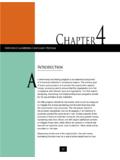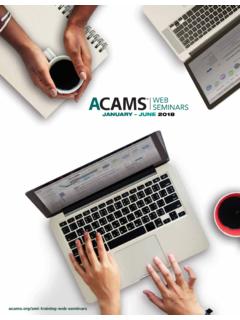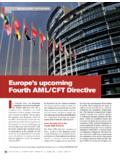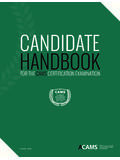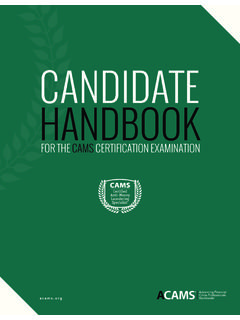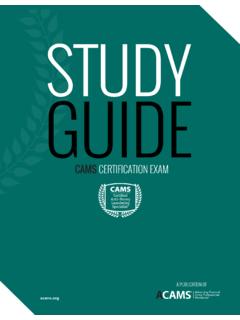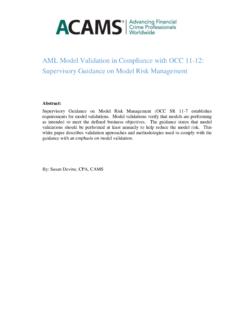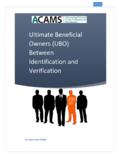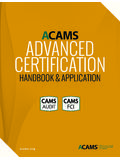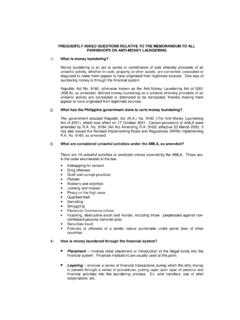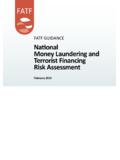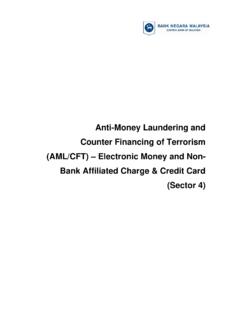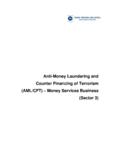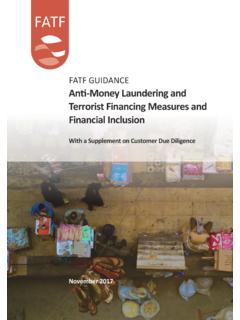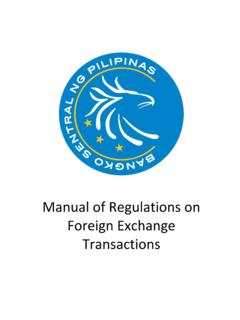Transcription of Implementing an Effective Anti-Money Laundering System
1 Implementing an Effective Anti-Money Laundering System By Kevin Harris 1|P ag e Contents Executive Summary .. 3. Introduction .. 4. Choosing a Software .. 4. 314(a) Screening .. 5. 314(b).. 5. Currency Transaction Reporting .. 6. Currency Transaction Reports Exemption .. 7. Case Management .. 7. Watch List Screening .. 8. SAR 8. Dashboard Reporting .. 9. Cloud 10. IT Resources .. 10. Testing and System Validation .. 11. 13. Works 14. 2|P ag e Executive Summary Increased pressure from regulators have Bank Secrecy Act/ Anti-Money Laundering (BSA/AML) officers turning to software vendors for solutions which can add efficiency and accuracy to their program.
2 Financial institutions must choose a software vendor solution that is right for their institution's size and risk appetite. While larger financial institutions may have the ability to custom build software, many smaller institutions rely on software vendor solutions to provide them with an all-inclusive solution. This white paper should serve as a tool for BSA/AML officers who are looking to implement an automated AML. software and provide real world guidance as it relates to the planning, resource, and validation stages of Implementing the software.
3 This white paper will provide insight into some of the many technical pitfalls in which BSA/AML officers commonly find during the implementation process. It will outline various tools available within most AML software, considerations to be had while Implementing a new AML software, IT and staffing resources, and discuss the importance of a System validation. Financial institutions may be looking for a comprehensive application that can perform services such as 314(a) screening, 314(b) communications, currency transaction report (CTR) filing and exemptions, case management services, watch list screening, suspicious activity report (SAR) filing, and dashboard reporting.
4 Incorporating all of these products into one software solution can be a challenge, but if they are implemented correctly, it will help the institution ensure overall compliance with the BSA. Financial institutions must also consider the technology resources required to take on such a project. There are advantages and disadvantages to working with software vendors who store data in the cloud. Cloud- based monitoring can free up IT resources and allow for additional cloud sharing or the institution may want to go with a server- based software which can only be accessed by their IT department for more control over safe guarding customer information.
5 Financial institutions must carefully plan on receiving additional resources from IT as well as additional staffing in the BSA/AML department when Implementing an AML software. Resources will be required during the initial implementation stage and also throughout the life of the software. With more institutions turning to automated solutions, regulators are looking to ensure that systems are validated and optimized for the best performance without missing vital data. A project of this size can take an enormous amount of IT resources to implement and institutions should be aware of the time and resources needed prior to signing the contract.
6 3|P ag e Introduction The days of fumbling through page after page of manual reports are long gone. With today's technology, financial institutions are expected to have an AML software in place. BSA/AML. officers are required to wear multiple hats, including, but not limited, to software specialist. Continued scrutiny from regulators regarding AML software model validation has pushed some BSA officers to become experts at Implementing and validating software. Financial institutions are looking at their AML software systems for ways to expand automation, improve performance, standardize processes and increase Rules- based monitoring systems are becoming less Effective as criminals increase their knowledge and find new ways to commit crimes undetected.
7 Some financial institutions are turning to a behavior- based AML solution to help predict patterns of activity indicative of money Laundering and fraud activities. In addition, financial institutions are fine tuning AML. software to enhance the effectiveness and timeliness of the investigative process. Financial institutions that spend time fine tuning their software will be rewarded with better quality alerts, less false positives and an overall more productive BSA program. In addition, the institution will be able to produce better quality SARs, which can help law enforcement identify and prosecute criminals.
8 The process of finding a software solution suitable to the institution's needs and desires can be demanding and at times can also create additional work for staff that may already be stretched thin. When determining the best AML. software solution for the financial institution, it is imperative that the BSA/AML officer reviews all aspects of the AML software and determine what is essential to their institution. Choosing a Software When choosing an AML software solution, the financial institution must first determine the required functionality needed to complement its BSA program.
9 Financial institutions may determine that in some instances, its System and processes in place are more than adequate and will not want to replace its current software with new technology. For example, a financial institution may find that it already screens its customer database against a multitude of watch lists and that using a new software vendor will not enhance its program. On the other hand, it may be beneficial for the financial institution to consider consolidating its systems for overall optimization.
10 BSA/AML officers may want to weigh the benefits of consolidating systems with using the current software. Financial institutions may be looking for a comprehensive application that can perform services such as 314(a). screening, 314(b) communications, CTR filing and exemptions, case management services, watch list screening, SAR filing and dashboard reporting. Incorporating all of these 1. (Singh). 4|P ag e products into one software solution can be a challenge, but if they are implemented correctly, it will help the financial institution ensure overall compliance with the BSA.
